10 small garden planting ideas that really work
Small garden planting is often different from planting in large gardens. Colour and shape work differently in a smaller space.
This is Part 2 of ‘10 garden planting ideas for small garden.’
It features the garden of garden designer Posy Gentles. Her own garden is 100ft x 20ft, so it’s very narrow. She uses it as an experimental garden, finding out what works and what doesn’t.
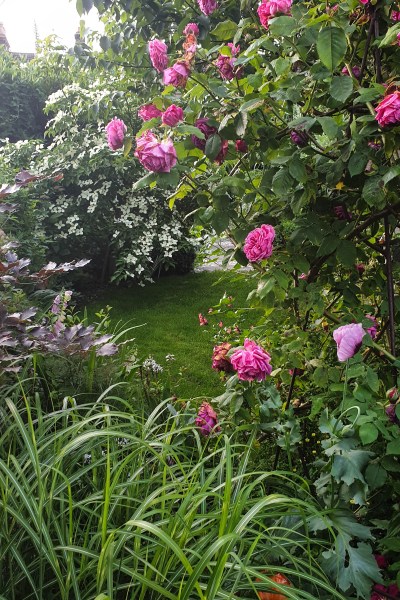
Posy Gentles’ small garden planting ideas are tried out in her own garden. She has contrasting leaf shapes, plants that reflect light, small flowers that ‘glitter’ and plants with movement.
Posy’s top 10 tips for small garden planting:
- Use evergreens for structure and as punctuation points
- Add vertical planting -trees and spires – so the eye goes up
- You don’t need to plant in 3s and 5s – you’re not aiming for a ‘drift’ but can enjoy individual plants close up.
- Always have one or more trees to use vertical space
- Make your garden ‘glitter’ – add soft colours and small flowers
- Climbers take the garden upwards and blur boundaries.
- Contrast leaf colours and shapes
- Add light with variegated or glossy leaves
- Choose plants with movement instead of chunky blocks of colour.
- Use scale for contrast. Big leaves and big plants next to smaller ones
We went into more detail on the first five points in the first post about small garden planting ideas.
For example, a herbaceous border with blocks of beautiful colour looks wonderful in a large garden. You can walk past it, enjoying the play of colour over a large canvas.
But in a small garden, a border filled with chunky shrubs and drifts of perennials would occupy all the planting space and block off the rest of the garden visually.
So Posy recommends using flowers with movement and airy plants, so that you can see through the garden.
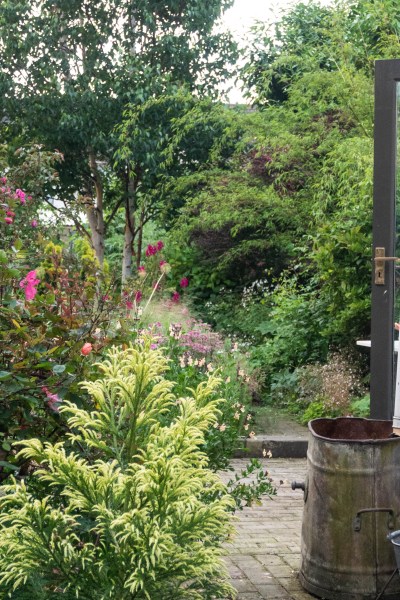
Posy has blurred the boundaries of her garden by using these small garden planting ideas. Your eye is drawn to a journey down the garden and is less aware of the narrow boundaries.
Make the most of vertical space in a small garden
The space in your garden is not just at ground level. You can plant climbers up the walls and into trees. ‘A clematis that climbs up your wall and into a tree blurs your boundaries,’ says Posy.
‘I only use Group 3 clematis in a small garden. That’s because they climb up in a single season, then you cut them down to six inches above the ground the following February. Then they climb up again by the summer. This means they’re not occupying space in the garden all year round. A Clematis montana, for example, will occupy space in your garden even when it isn’t in flower.’
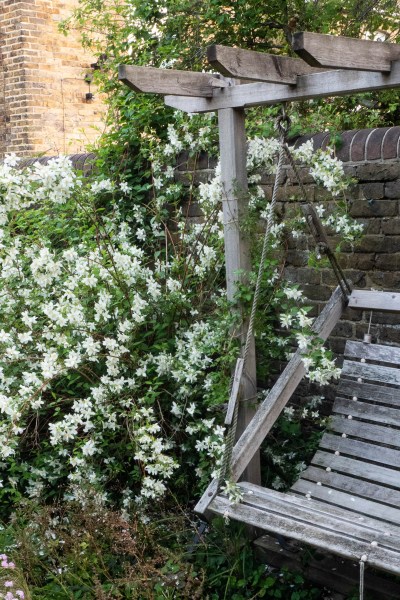
These pretty white philadelphus flowers add what Posy calls ‘glitter’ to her garden. The flowers are small but there are lots of them, and they work well in whites, pastels or bright colours.
Contrast is important in small garden planting
Contrast is important in both small and large gardens. Pick plants with different shapes or colours of leaves, and contrast small plants with larger ones. But in smaller gardens, you can plant just one of each plant. You don’t have to plant in threes and fives, which is recommended for larger gardens. You’re not aiming for a ‘drift’ in a small garden.
And the plants are close up. So you can really enjoy the difference between a small feathery leaf and a large glossy one. Posy contrasts leaf and plant shapes in her narrow town garden.

Here the soft flowers and rounded leaves of clematis contrast with Yucca gloriosa ‘Variegata’.
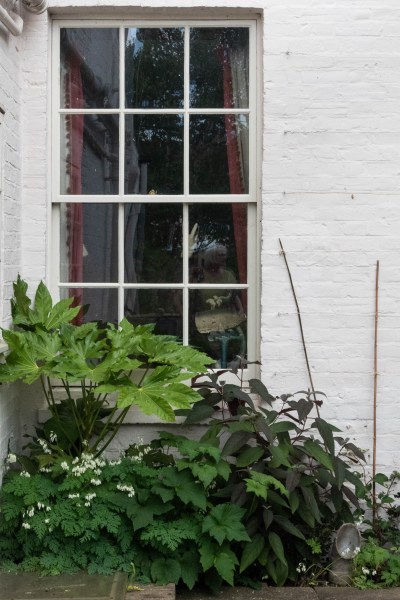
The broad glossy leaves of a variegated False Castor Oil Plant (Fatsia japonica) contrast with the pointy dark felted leaves of a hydrangea and feathery leaves in Posy’s back yard.
Add light with variegated and glossy leaves
Small gardens are more likely to be dark than large ones. They are usually in towns, so are shaded by buildings, walls and trees.
To add light, Posy suggests using variegated leaves and glossy leaves that reflect light. She recommends Variegated shrubby honeysuckle (Lonicera nitida ‘Silver Beauty’), Variegated hebe (Hebe glaucophylla variegata) and Variegated beech (Fagus sylvatica ‘Franken’) as good variegated plants for small gardens.
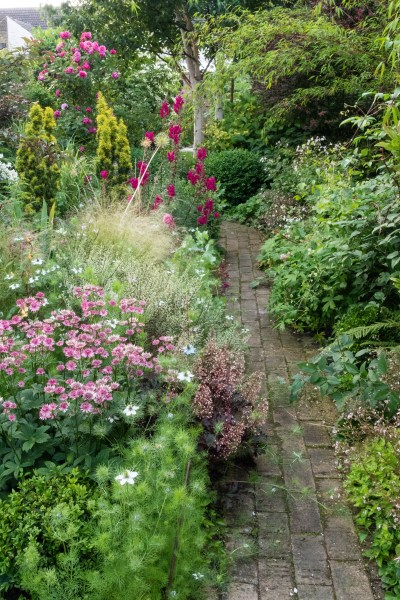
See how the variegated hebe (middle plant on the left hand side of the path) adds to the light. It’s between the pink astrantia (which adds glitter to the border) and the stipa tenuissima which adds movement.
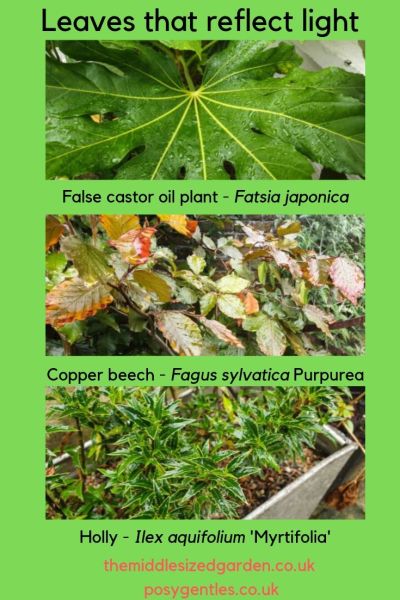
Three of Posy’s recommended leaves that reflect light
Choose plants with movement instead of blocks
Whether you’re choosing plants for colour or greenery, think about how the plants move, advises Posy. For example, she has a gracefully weeping bamboo (Himalayacalamus falconeri), an airy Stipa tenuissima and a type of hollyhock that has tiny flowers on tall stems that wave in the breeze (Althaea cannabina).
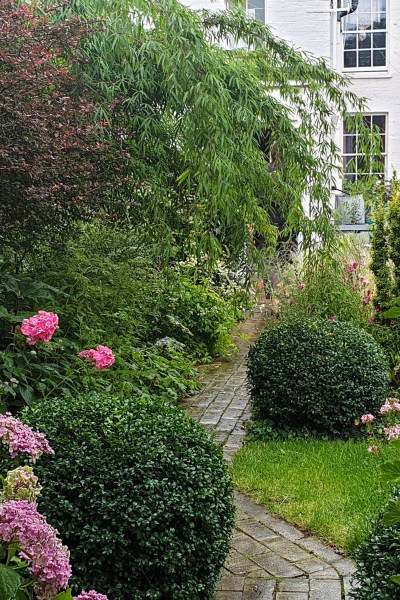
The gracefully arching stems of Bamboo (Himalayacalamus falconeri) move gently in the breeze, creating movement in Posy’s small garden.
Her flower choices also have movement, with small profuse flowers. She calls this ‘soft focus’ because the flowers and foliage can be almost transparent, like a layer of gauze over the border. For more about this, see part 1 of Garden planting ideas for small gardens).
Astrantia, nicotiana, salvia, Nigella and bronze fennel all have combine many good planting characteristics for small gardens. Salvias, bronze fennel and nicotiana are tall but they don’t block the view. And the small flowers of astrantias and Nigella also add colour without being too solid.
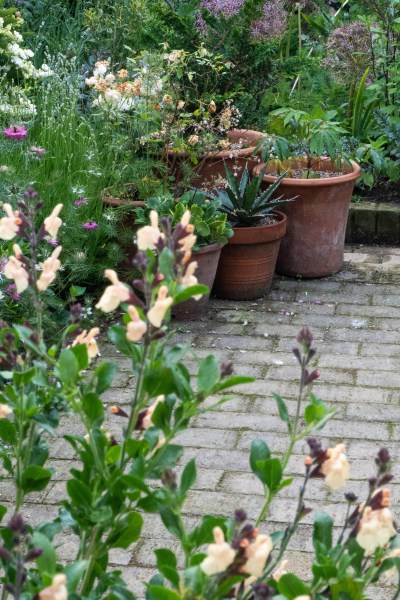
Salvias add vertical interest and some movement, but you can see the garden beyond them.
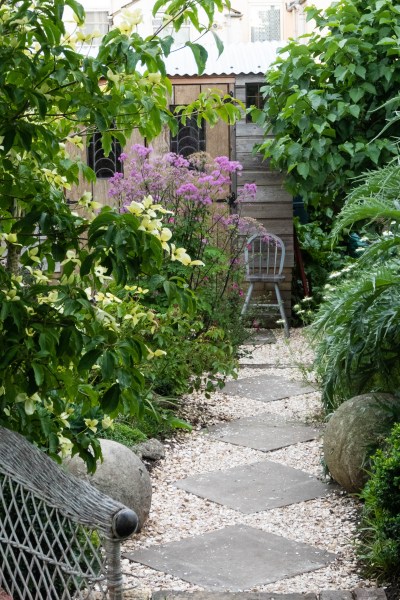
Tall airy Thalictrum provides the colour, while contrasting leaf shapes and architectural plants such as cardoon and box make Posy’s small garden look charming.
Contrast with scale – put large next to small
This tip can apply to leaves, flowers or whole plants. Although Posy thinks that small flowers generally work well in small gardens, she also thinks that it’s important to have some large plants or leaves in a small garden. This year she has had two giant echiums at the bottom of the garden, reaching over ten feet into the sky. The pollinators have loved them.
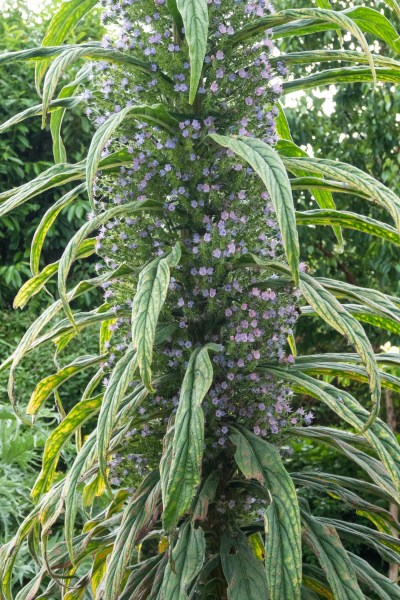
Big plants work well in small gardens. Posy’s echium attract pollinators.
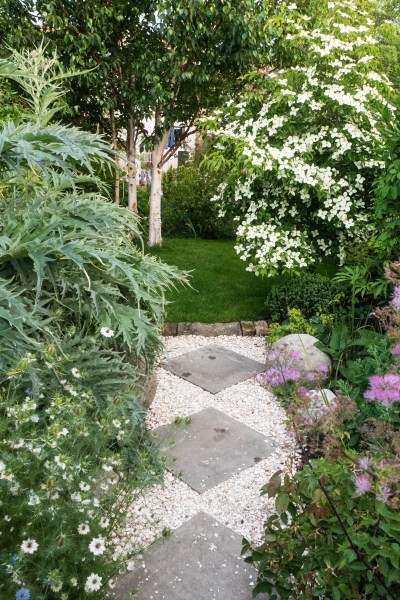
The rounded prettiness of Cornus ‘Norman Haddon’ (top right) contrasts with the spiky grey leaves of Cardoon, the soft focus Nigella flowers (bottom left) and the straight-up verticals of the silver birch trees.
More small garden design help
Find out more in this post with part 1 of 10 small garden planting ideas. There is also good small garden planting inspiration in the small town garden transformation carried out by Great British Bake Off finalist and garden designer Jane Beedle.
See here for Posy Gentles’ garden design.
It’s worth having a couple of useful books that help you think about what to plant in your garden. Keep them beside your bed and flick through them for inspiration. Two of my favourites are The Bold and Brilliant Garden by Sarah Raven and Colour for Adventurous Gardeners by Christopher Lloyd.
Note that links to Amazon are affiliate and as an Amazon Associate I earn from qualifying purchases. See disclosure.
I also found The New Wild Garden by Ian Hodgson, both inspiring and informative. Although not aimed at small gardens, the wildlife-friendly plants on its pages have the airy characteristics and vertical spires of good plants for small gardens. And they are loved by pollinators.
I’m often asked for recommendations so I’ve put together some useful lists of my favourite gardening books, tools and products on the Middlesized Garden Amazon store. For example, if you want a list of essential garden tools, I’ve listed them with the brands I use.
This week’s video – the secret of growing dahlias
Steven Edney, the award-winning Head Gardener of the Salutation Hotel & Gardens, (now closed) comes from a family of professional dahlia growers. He tells us what we need to know about choosing and growing dahlias, in the gorgeous gardens of The Salutation.
Pin to remember small garden planting ideas
And do join us every Sunday morning for tips, ideas and inspiration for your small (middle-sized!) garden. Fill in the ‘follow by email’ box below.
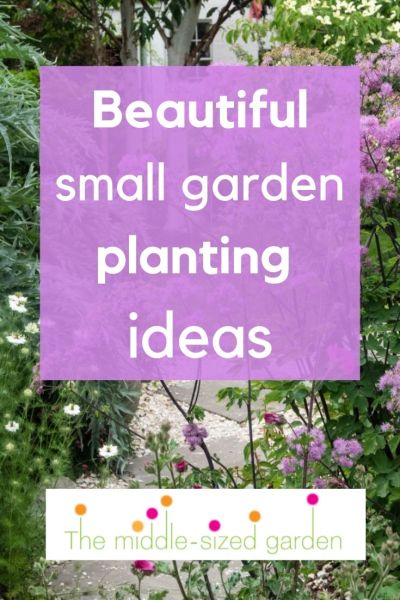























I’m moving from a flat to a house with a small garden soon and I’m looking forward to being able to do some gardening again.
Thankyou very much for these articles they are very informative and easy to read.
Thank you!
Could you tell me the name of the feathery leaved plant below the False Castor?
It’s a dicentra. Posy doesn’t know which type, but at least that’s a start!
Thanks to your clear guidance. You reminded me of things I should know but had forgotten. Once i had a Clematis montana, and after reading your article i realize that i need Group 3 clematis. Because it is One of the best compact singles.
Can’t thank you enough.
Thank you! I had a Clematis montana once and I pruned it one evening after a glass of wine, and accidentally chopped it down completely. It never recovered.
Absolutely wonderful posts, I will be coming back to these as I add to my garden.
Thank you!
Thank you for the wonderful interview about dahlias. It was most interesting! We’ve had some wonderful dahlias this year, now to see if I can keep them for next year :)
Hope you do!